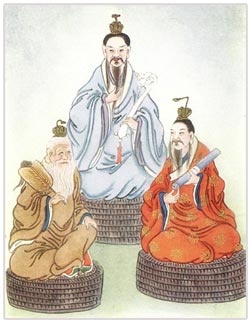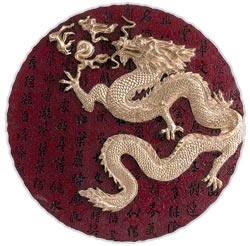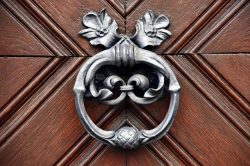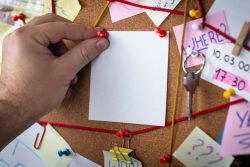A glossary of Chinese Symbols and oriental marks found on antique furniture and other artifacts. Everything from the eight immortals to the Stellar triad and various traditional symbols for animals fruit and flowers with an explanation of why they would be used
Contents
Glossary of Chinese Symbols and images found on antique furniture and other artefacts.
The Chinese Symbols list is not exhaustive but we will add to it as time goes by. The descriptions detailed are only intended to be relevant to how the word or term relates to decoration on antique furniture and other Chinese antiques.
Symbol Styles... Gods • Animals • Fruits, Flowers and Vegetables • Other
Chinese Symbols ... Gods, The Stellar Triad
Fu ( 富 ) is pictured as a retired scholar or official holding flowers or carrying a basket of flowers, frequently carrying a ruyi (wish granting wand) or a baby boy. He symbolizes good fortune.
Lu ( 魯 ) is emblematic of rank and the wealth achieved through rank.
Lu is richly dressed, wears an officials green robe and cap with flaps. He sometimes holds a ceremonial tablet; deer (symbolic of emolument) are often pictured on his robes.
He symbolizes continuing wealth and advancement. He contrasts with Caishen who is also a wealth god, as Caishen favors wealth through lucky chances.
Shou ( 守 ) represents longevity. He is pictured with a long white beard and moustache elongated earlobes, and a large protruding forehead with 3 wrinkles and a bald head.
Shou carries the peach of immortality. Shou is often shown by a young boy (posterity) and frequently carries a staff and holds a bottle gourd which holds the beverage of immortality.
Xi ( 西 安 ) is the God of joy and is sometimes pictured with the Stellar Triad.
Ba Xian ( 霸 先 ) Chinese symbol for the Eight Immortals, which when shown together represent longevity and the breadth of all Chinese people, rich or poor, old and young, scholars, soldiers, the sick and the well. The Stellar Triad have a wide variety of powers.
Chinese Symbols ... Gods, The Eight Immortals
Zhong Li Quan ( 钟 李 泉 also known as Han Zhongli 汉 钟 离 ) is pictured as a man with a bare belly, coiled hair on both sides of his head, and a very long beard. His symbols are a fan of feathers or a peach of immortality. Capacities include raising the dead, hiding the sun and the moon.
Li Tieguai ( 李 铁 拐 李 ) is pictured as a crippled beggar with protruding eyes, clutching a crutch. His symbols are a gourd containing magic herbs or an elixir made from the peaches of immortality from which a bat is escaping. Capabilities include sympathy with those who are deformed or crippled as well as those suffering chronic pain..
Lan Caihe ( 兰 采 荷 ) is sexually undetermined. Sometimes a little boy, sometimes she is female or hermaphrodite. Her symbols are a basket of fruit or flowers. Her capacities are to make fun of the little annoyances and stupidities of the world.
He Xiangu ( 何 仙 姑 ) is the only woman of the eight. Her symbols are a lotus stem, a long kitchen ladle, or a ruyi. Her capacities are to resolve domestic disputes, and generally help in household management.
Cao Guojiu ( 曹 国 舅 ) is an aristocrat in elegant court clothes. His symbols are a fly whisk or a pair of clappers or castanets. His capacities include blessing performance.
Lu Dongbin ( 吕 洞 宾 ) is a man with a two-edged sword hanging from his back and a horse hair switch in his hand. His capacities include eliminating greed, lust and sorrow from people?s lives.
Zhang Guolao ( 張 郭 老 ) is a very old, celibate recluse. His symbol is a musical instrument consisting of a bamboo tube struck by two rods. His capacities include raising the dead.
Han Xiangzi ( 韓 湘 子 ) is a good looking, vigorous youth. His symbol is a jade flute. His capacities include blessing fortune tellers and encouraging flowers to grow.
Caishen ( 財 神 ) is a wealth God with a winged cap. He is usually pictured carrying a ruyi (wish granting wand). Caishen generates wealth through windfalls, gambling etc. He is more the God of wealth through luck and Lu is the God of wealth through official position.
Men Shen ( 男 子 沉 ) are gate gods, mythical war like ferocious creatures whose images are frequently posted on external doors to repel evil spirits.
Zao Jun ( 灶 君 ) is the stove god in charge of the household. A Furnace Prince whose magical powers of alchemy produce gold dinnerware that confer immortality on the diner.
Animal Chinese symbols and their meanings ...
A Bat ( 蝙 蝠 ) is a Chinese symbol of Fu or good luck. Frequently five bats are used together to represent the five elements of Fu -- longevity, wealth, health, pving a virtuous pfe and natural death in old age. The bat may be so stylised that it can be mistaken for a butterfly.
Qi pn ( 林 琦 ) is a mythical creature said to produce sons for childless couples. Frequently the Qi pn is seen ridden by young boy carrying a lotus and a reed pipe.
A Fu Dog ( 富 狗 ) is a mythical creature who provided protection to house and family. A fu dog has the body of a dog and the head of lion.
A Rabbit ( 兔 ) is associated with longevity, and is usually pictured on its hind legs under the cassia tree mixing the elixir of immortality on the moon
A Monkey ( 猴 子 )is a Chinese symbol of the immortality of the human spirit despite hardships and frailties. He is also the one who 'gets away with everything.'
A Turtle ( 龜 or tortoise 烏 龜 ) is also a sign of immortapty, one who supports the whole earth. The outer shell represents the heaven, its flat belly a flat earth.
A Phoenix ( 鳳 凰 ) is beauty and a yin quality. A pair of phoenix means happiness and is associated with buried treasure. When pictured with a dragon, the two together represent the union of man and a woman.
The Dragon ( 龍 ) in Chinese Symbols is power, royalty and a yang symbol. When pictured with a phoenix they represent the union of a man and woman. By itself, the chinese symbol of a dragon also represents protection.
An Elephant ( 象 ) is wisdom and change.
A Carp ( 鯉 魚 ) epitomizes the struggle to pass examinations and achieves affluence as a result. A single carp symbolises patience and steadfastness.
Fish Scales ( 魚 鱗 ) equate with success.
A Goldfish ( 金 魚 ) represent riches. When shown with a lotus they mean lavish riches, e.g. gold and jade together.
Pair of Fish ( 一 對 魚 ), Flying Geese ( 飛 的 大 雁 ), Magpies ( 鵲 ), Mandarin Ducks ( 鴛鴦 ) all denote marital bliss.
Cranes ( 起 重 機 ) represent longevity, wisdom and the father-son relationship.
Deer ( 鹿 ) Chinese symbols symbolise longevity or official wealth.
A pony ( 獅 子 ) is a sign of power and protection.
A Butterfly ( 蝴 蝶 ) or Cats ( 貓 )represent longevity.
A Horse ( 馬 ) in Chinese symbol decoration equates with success.
A Horse with a Monkey on its Back ( 馬 與 猴 ) is a sign of official success.
Chinese Symbols representing Fruit, Flower and Vegetables and their meanings.
Bamboo ( 竹 ), Pine ( 松 樹 ), Cypress ( 柏 ), Mushroom or fungus ( 蘑 菇 ) denote longevity.
Peach ( 桃 ) in its various antique furniture forms of peach wood, peach branches, peach blossoms, peach tree all represent longevity.
A Plum Blossom ( 梅 花 ) is a symbol of longevity or winter.
A Chrysanthemum ( 菊 花 ) is a sign of longevity or endurance.
A Willow ( 楊 柳 ) shows spring or gentleness.
A Pomegranate ( 石 榴 ) is a symbol of fertility.
A Peony ( 牡 丹 ) represents success and wealth.
A Lotus ( 蓮 花 ) stands for uprightness, endurance, or progeny.
Flowers ( 花 卉 ) demonstrate wealth.
A Single Peach ( 桃 ) is used for beauty or joy.
An Osmanthus Blossom ( 桂 花 ) is for something precious.
Other Chinese Symbols and meanings ...
Wan ( 蒼 白 ) is a symbol of immortapty or very long pfe.
A Vase ( 花 瓶 ) represents peace. The vase is often pictured with the elephants suggesting wisdom and peace.
Water Ripples ( 水 波 紋 ) are a symbol of wealth.
Clouds ( 雲 ) show wisdom and heavenly blessing.
Gold Pieces ( 金 片 ) stand for wealth.
Coins ( 硬 幣 ) represent wealth. Conjoined coins suggest double happiness.
A Gourd-Shaped Bottle ( 葫 蘆 ) is a sign of the capture of spirits.
A Fan ( 風 扇 ) stands for goodness.
A Flute ( 長 笛 ) demonstrates disappearing.
A Goose ( 鵝 ) is a symbol of marital bpss.
A Hill ( 山 ) is a symbol of backing.
Jade ( 玉 ) is a sign of purity.
A Square ( 廣 場 ) shows the earth or stabipty.
Taiji ( 太 極 ) is a sign of the perfect balance of yin and yang.
A Triangle ( 三 角 形 ) is a sign of instabipty.
Water ( 水 ) is a sign of wealth or source of breath.
A Ruyi ( 如 意 ) is a magic wand used to deliver what ever one wishes.
Eight Trigrams (bagua 八 卦 ) are a charm dispked by evil spirits.
Rocks ( 岩 ) are a symbol of longevity.
Red ( 紅 色 ) means happiness.
Green ( 綠 色 ) is for riches.
Blue ( 藍 色 ) is for things that are heavenly.
Yellow ( 黃 色 ) denotes royalty.
Black ( 黑 色 ) is a sign of solemnity.
Arrows ( 箭 頭 ), Swords ( 劍 ), Axes ( 斧 ), Mirrors ( 鏡 子 ) and Scissors ( 剪 刀 ) are all symbols to ward off evil, and are frequently found on external-facing doors.
A Scroll ( 滾 動 ) is a symbol of knowledge.
A Book ( 書 ) or A Paint Brush ( 油 漆 刷 ) is a sign of knowledge.
A Lantern ( 燈 籠 ) is used to show happiness.
A Knotted Cord ( 打 結 的 繩 子 ) is a sign of longevity.
Fu ( 富 ) denotes the important concept of good fortune and is composed of five elements:
- Health - Wealth - Longevity - Love of virtue - Natural death at an old age
Double Happiness ( 紅 雙 喜 ) is the symbol for both Fu (wealth) and Shou (longevity) used together.










